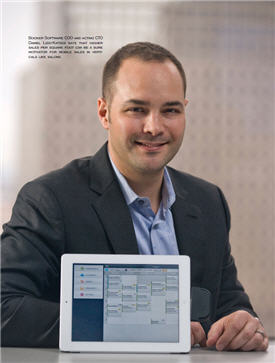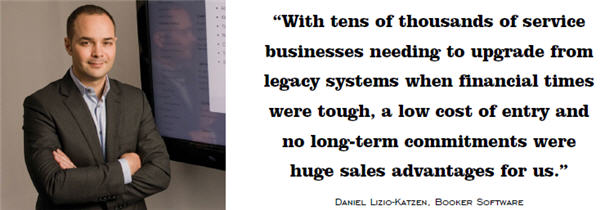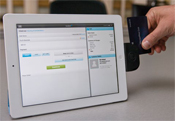Salons And Service: Hot Industries For Recurring Revenue

By Matt Pillar, chief editor
This ISV (independent software vendor) is building a giant business in a crowded market by creating subscription-based software applications for a variety of hospitality and service-based retailers.

Most service-oriented software start-ups are born of an unfilled market need. A group of smart people get together and realize there’s a gap in the software solutions needed to run businesses in a growing industry, so they gather some funding and hire some programmers and rush to be first-to-market.
When it launched in 2007, the company that’s known today as Booker Software was not typical of most service-oriented software start-ups. In fact, the market it dove into headlong was a crowded one, with more than 60 separate competitors serving a huge, but highly fragmented, space. This is the story of how Booker is shaking up the $7 trillion services market by building a SaaS-based suite of software tools for service-based businesses.
An Early Adopter Of SOA
In 2006, Booker was just an idea inside of SpaFinder, which can be loosely defined as the Expedia of the health and wellness market. The Booker division was charged with acting as the online reservation management tool for SpaFinder, which sells gift cards and manages loyalty programs for its many-thousand spa and wellness center clients. But Daniel Lizio-Katzen — COO and acting CTO for Booker — faced an uphill battle making the reservation management tool work. Many SpaFinder spas already used one or more of the 60+ reservation tools on the market to manage their internal operations. Not one of these point solutions owned more than 6% of the market. Most were written for early versions of Windows and even DOS, plus a few for the Mac platform. None of them were hosted. “We initially wanted to integrate with the point solutions that had larger installed bases, but it quickly became clear that would be difficult, if not impossible,” says Lizio-Katzen. Instead, SpaFinder launched a scheduling extranet, which allowed SpaFinder spas to log in and load their service menus and reservation availability to the SpaFinder site. This dis-integrated approach resulted in the typical extranet dilemma that besieged the first iterations of similar sites like Expedia and Orbitz; SpaFinder’s spas became lax about keeping the extranet at SpaFinder.com up to date, resulting in poor visibility and inaccurate schedules on the consumer-facing side. By early 2007, what is now the Booker team knew what they had to do. It was time to launch a system-of-record software product and begin to supplant its competitors. In June 2007, it launched a beta version of SpaBooker, a first-of-its-kind hosted software suite that included basic POS and staff management applications along with its customer reservation tool. Soon, it had more than 30 customers operating on the beta version.
That’s when the company got its first big break. SpaFinder CEO Peter Ellis was approached by Hilton Hotels, which had a big problem managing the integration of the 12 different computer systems that ran its worldwide hotel-based spas. Hilton was ready for something new, but no one was sure SpaBooker was ready for Hilton. This pilot became the proving ground for new functionality, including multicurrency acceptance and support of multiple languages. By 2008, SpaFinder and its SpaBooker application boasted Hilton Hotels as its flagship customer.
SaaS Helps Launch A Company On The Heels Of Recession
With a growing customer base and some high-profile brands finding success with SpaBooker applications, Lizio-Katzen says his company devoted itself to adding features and functionality to the platform, including email marketing, social media integration, inventory management, and CRM applications. The Great Recession was gathering a full head of steam at the time, but Lizio- Katzen says SpaBooker had a great advantage feeding its growth. “We were able to sell right through the recession because we were the cost leaders. Most of our competitors were selling a traditional software license, while we were selling monthly subscriptions to our SaaS platform,” he explains. “With tens of thousands of service businesses needing to upgrade from legacy systems when financial times were tough, a low cost of entry and no long-term commitments were huge sales advantages for us.” It also helped that the new software company’s affiliation with SpaFinder gave its customers the advantage of an enterprise system designed to bring them new customers along the way.
By the second half of 2009, the company was entertaining an increasing volume of referrals from companies on the fringe of its endemic spa and salon market. Chiropractors, medical spas, fitness businesses, and pet grooming centers came knocking.
As new customers sought SpaBooker and the economy began to improve, management made the bold decision in October 2010 to spin the company away from its parent and become a stand-alone operation. Its POS application processed more than $190 million in sales on behalf of its clients that year.
It’s spent the years since the spinout expanding its solution set, winning new customers, and raising tens of millions of dollars in funding from the likes of Bain Venture Capital, Grotech Ventures, Jubilee Investments, Revolution Ventures, and TDF. That venture capital has helped the company expand to 65 employees by the end of 2011, 175 at the close of last year, and 230 employees today. Proving the “if you build it, they will come” theory correct, Booker POS sales volume has experienced incredible growth as the company invested in new technology and personnel. Booker customers processed $415 million in sales in 2011 and $875 million last year; this year’s forecast approaches an astounding $2 billion.
What SaaS Sells Today, And Who’s Buying It
What began a mere seven years ago as a bolt-on reservation management application for SpaFinder has blossomed into a complete ERP system for both Fortune 500 companies and thousands of small-to-midsize services companies. In fact, it boasts more than 7,500 merchants on the platform today, though Lizio-Katzen says that’s just a small piece of the service-based business pie. “Figures vary by source, but there are some 20,000 discrete spa locations in the U.S. alone and up to 500,000 salons. We see pet services as a $20 billion market. There’s increasing interest from the automotive services segment. Virtually any retailer that takes reservations or makes appointments is an opportunity for Booker,” he says. The Booker reservation and scheduling application facilitated more than 12 million reservations in 2012 and 1.65 million reservations in March 2013 alone. Lizio-Katzen says the company’s SaaS delivery model enables it to cost-effectively serve such a diverse array of customers. He says the initial refusal to give up on-premise applications has largely faded into the background, in part because of tight capital budgets and in part because retailers are gaining confidence in the Web interface. “Most retailers use IP connectivity for credit card terminals, so moving to a pure Web-based POS terminal is just another step in the progression, another interface,” says Lizio-Katzen. But even when pushback on cloud computing was common, Lizio- Katzen says Booker had no choice but to sell it as its base of Fortune 500 clients grew. “We aren’t in the business of operating data centers — we go to Rackspace for that, and we get stellar uptime from them that enables us to deliver market-leading system uptime in all 73 of the countries where we’re used.”

Another upside of running its entire suite in the cloud, says Lizio-Katzen, is the ability to look at customer metrics in aggregate. “We can tap into usage data in subsets to see how the platform is being used and how we can make it better. We can conduct A/B testing very easily, helping us continually improve the product suite. That’s very difficult, if even possible, in a traditional on-premise environment.”
The ability to quickly develop modules that retailers can turn on or off is another benefit of developing for SaaS delivery. “Today, every one of our retailers is using the same version of our platform. It can be accessed through a browser, through native applications for mobile deployment on iOS and Android, and all of the data is stored in the same data structure,” he says. On the mobile note, Lizio-Katzen advises mobile POS resellers to target retailers where space is highly valuable or at a premium. “In the salon business, for instance, the space taken up by the front desk could be devoted to one or more revenue-generating service stations,” he says. “Higher sales per square foot can be a sure motivator for mobile sales.”
CRM/Marketing Modules Poised For Growth
Among the advanced features that have contributed to the company’s growth is a back end scheduling interface that helps service businesses track staff availability and skill level, physical resource availability, and equipment availability — from nail stations and massage booths to automotive lifts and diagnostic computers. These are built into the consumer-facing scheduling application, giving the retailer visibility into the personnel and equipment available for the services of their choice.
The scheduling and POS applications Booker sells gather data that’s inherently valuable to the success of CRM, loyalty, and marketing applications. Any POS VAR — whether selling to a service-based retail sector or not — should be aware of the growing appetite for CRM, loyalty, and clienteling applications among retailers. “Every appointment has a customer attached to it, so when we link our scheduling, CRM, and POS modules, we can deliver deep data on consumers’ spending, frequency, loyalty, etc., which our retailers find quite valuable,” says Lizio-Katzen. “With that consumer-specific intelligence, we’re able to serve our retailers with a marketing application that helps them create targeted promotions using email and social media.”
Now that Booker has successfully made the transition from integrator to ISV, the company has warmed to the idea of building a channel. “The services industry represents up to half of our nation’s GDP. Out of that, there are more than a million SMBs in the U.S. that make appointments that Booker can handle,” says Lizio-Katzen. “The opportunity to gain market share is terrific. If there are resellers interested in our products and willing to bring their domain expertise to the table, we’re interested in talking to them.” If its recent fast and wild success is any indication, Lizio-Katzen and his team at Booker will be doing a lot of talking.

